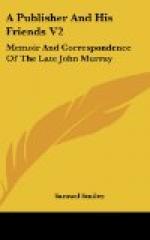There were then two young advocates walking the Parliament House in search of briefs. These were John Wilson (Christopher North) and John Gibson Lockhart (afterwards editor of the Quarterly). Both were West-countrymen—Wilson, the son of a wealthy Paisley manufacturer, and Lockhart, the son of the minister of Cambusnethan, in Lanarkshire—and both had received the best of educations, Wilson, the robust Christian, having carried off the Newdigate prize at Oxford, and Lockhart, having gained the Snell foundation at Glasgow, was sent to Balliol, and took a first class in classics in 1813. These, with Dr. Maginn—under the sobriquet of “Morgan O’Dogherty,”—Hogg—the Ettrick Shepherd,—De Quincey—the Opium-eater,—Thomas Mitchell, and others, were the principal writers in Blackwood.
No. 7, the first of the new series, created an unprecedented stir in Edinburgh. It came out on October 1, 1817, and sold very rapidly, but after 10,000 had been struck off it was suppressed, and could be had neither for love nor money. The cause of this sudden attraction was an article headed “Translation from an Ancient Chaldee Manuscript,” purporting to be an extract from some newly discovered historical document, every paragraph of which contained a special hit at some particular person well known in Edinburgh society. There was very little ill-nature in it; at least, nothing like the amount which it excited in those who were, or imagined themselves to be, caricatured in it. Constable, the “Crafty,” and Pringle and Cleghorn, editors of the Edinburgh Magazine, as well as Jeffrey, editor of the Edinburgh Review, came in for their share of burlesque description.
Among the persons delineated in the article were the publisher of Blackwood’s Edinburgh Magazine, whose name “was as it had been, the colour of Ebony”: indeed the name of Old Ebony long clung to the journal. The principal writers of the article were themselves included in the caricature. Hogg, the Ettrick Shepherd, was described as “the great wild boar from the forest of Lebanon, and he roused up his spirit, and I saw him whetting his dreadful tusks for the battle.” Wilson was “the beautiful leopard,” and Lockhart “the scorpion,”—names which were afterwards hurled back at them with interest. Walter Scott was described as “the great magician who dwelleth in the old fastness, hard by the river Jordan, which is by the Border.” Mackenzie, Jameson, Leslie, Brewster, Tytler, Alison, M’Crie, Playfair, Lord Murray, the Duncans—in fact, all the leading men of Edinburgh were hit off in the same fashion.




